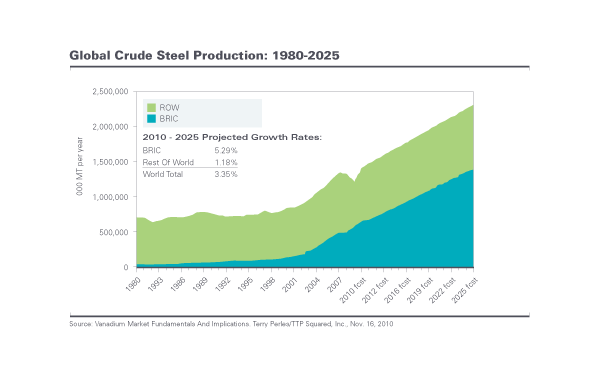When a very small amount of the strategic metal vanadium is added to steel, high-strength low-alloy vanadium steel ('HSLA-V steel' or 'V-steel') is created while greatly reducing shipping, energy and production costs.
In turn, the long list of benefits associated with V-steel – such as increased strength-to-weight ratio – enable superior end products across industries ranging from construction to automotive, aerospace, and more.1
And with the use of V-steel increasing – particularly in emerging economies in need of reliable yet cost-effective infrastructure development – specific vanadium use for steelmaking is forecast to grow significantly into the future.2
A Strong History of Use
In 1905, Henry Ford discovered a French-made steel-vanadium alloy. Impressed by its low weight and high strength, he used V-steel in the chassis of the Model-T, reducing the car's overall weight to about half that of contemporary automobiles.
Ford's superior product – stronger, lighter and cheaper – captured the auto market, allowing him to sell the majority of autos from 1908 to 1923.3
– Henry Ford, 1910 4
Since that time, new processes have continued to be developed that improve the effectiveness and benefits of using vanadium as an alloy with steel.
The result has been a great expansion in the use of V-steels,1 with roughly 92% of all vanadium consumed today being used in the expanding steel production market.2
V-Steel Advantages & Applications
High-strength low-alloy steels are predictably strengthened through the addition of less than or equal to 0.20% vanadium. In addition to increased strength-to-weight ratios, V-steels also provide weldability, ductility, elongation, good castability, and a long list of other advantages.1
By contributing to the reliability, machinability and cost-effectiveness of steel, vanadium is widely used in various steel products, from crankshafts and connecting rods to the chassis of many cars and trucks.
According to the Vanadium International Technical Committee (Vanitec), vanadium is the most widely used alloying element for strengthening steels used in buildings and bridges, and is the most effective alloy for increasing the strength of reinforcing bars used in construction.
Vanitec also points to the universal use of vanadium in steels and titanium alloys for aero-engine gas turbine applications, as well as in titanium alloys used for airframes.4
These are but a few of the growing list of steel-related industries and applications making using of vanadium today.
Opportunity for Market Gains
The vast majority of steel currently being produced is known as Carbon-Manganese steel (C-Mn steel). In comparison, it's estimated that vanadium is only used in about 9% of all steels today.
Vanadium's current level of market penetration represents room for significant potential market gains, especially due to V-steel delivering value-adding benefits across the entire supply chain:
- Steelmakers can sell V-steel at higher margins, allowing for greater profits with less steel required per project
- Steel buyers can build superior infrastructure while requiring significantly less steel and less money per project
- Less steel required per project means less energy consumed and less pollution generated
- Less steel required per project also means increased global steelmaking capacity with less investment capital required2
Vanadium Consumption & Emerging Markets
In the coming years, growth in global steel production and increased vanadium consumption within the steel industry are forecast to create very high rates of growth in demand for vanadium.
The increased adoption of V-steels is particularly expected among developing economies to meet their needs of reliable infrastructure development while minimizing related pollution.
Such developing economies represent the most significant growth in steel production globally since 1980, with 80% of total growth being attributed to China alone, and over 90% being attributed to BRIC countries (i.e., Brazil, Russia, India and China).2
Looking forward, China's 12th five-year economic plan emphasizes the use of high-strength low-alloy steels to minimize energy consumption, pollution, and capital investment needed to meet the nation's growing steelmaking capacity needs.5
1. HSLA-V Vanadium Steel Technology website, Jan. 14, 2011
2. Vanadium Market Fundamentals And Implications. Terry Perles/TTP Squared, Inc., Nov. 16, 2010
3. Managing Technological Innovation: Competitive Advantage from Change. Frederick Betz, 2003
4. Vanadium International Technical Committee (Vanitec) website, Jan. 14, 2011
5. China Metallurgical Newsletter, vol. 7, No. 14, July 28, 2005 (as cited in Vanadium Market Fundamentals and Implications. Terry Perles/TTP Squared, Inc.)


